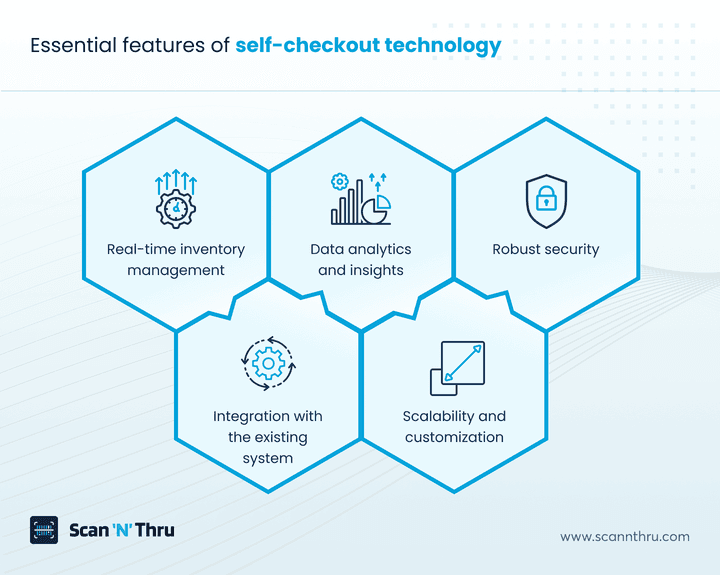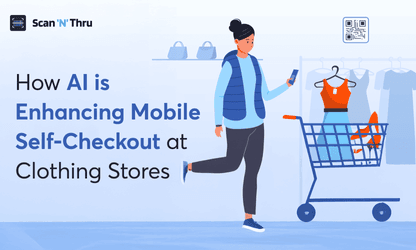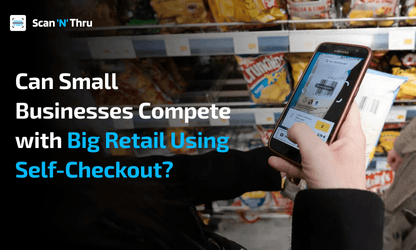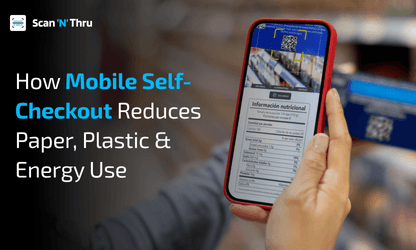Due to technological innovations and shifting consumer preferences, retailers have undergone transformations in how they operate and accept payments. Consumers now expect frictionless and the least time-consuming shopping journey.
To keep up with these consumer expectations, retailers have turned to self-checkout systems. The Deloitte Consumer Survey 2023 revealed that in 2023, 81% of consumers used self-scanning services compared to 74% in 2022 and 73% in 2021.
This steady rise in the use of this technology shows its success in adoption for both businesses and their customers.
More and more retailers are trying to stay competitive with this technology’s implementation, which brings us to the following question:
Why understanding key features of a self-checkout system is crucial for retailers?
For retail business owners like you, understanding the key features of self-checkout technology is vital. These features are not just technicalities; they directly impact your business’ operational efficiency, customer experience, and ultimately, profitability.
Fully understanding self-checkout technology presents numerous benefits for businesses like yours. You can integrate it into your existing operations, tailor it to meet your specific needs, and ensure a smooth implementation.
Read more: Here’s a comprehensive guide to help you understand scan and pay technology
Essential features of the self-checkout technology

When you are considering to implement a self-checkout system, you should look for the following features in it:
Real-time inventory management
Accurate stock levels
Businesses that use traditional inventory management have to do manual stock count, which is time-consuming and prone to errors. This is where self-checkout technology has the upper hand in providing real-time data on inventory levels.
These systems automatically update inventory as your customers scan items for shopping. This means you can always have an accurate stock level count.
With this accuracy, you can prevent overstocking and out-of-stock situations, which also affect your sales and storage space. This not only enhances operational efficiency but also ensures that customers find the products they need when they visit the store.
Automated reordering
Another really helpful feature of this system is automated reordering. This simply means that the system can automatically generate purchase orders for suppliers when the stock level falls below a predefined threshold.
This feature streamlines operations by minimizing the manual effort required to track inventory and reorder products. As a result, your business can maintain optimal stock levels, reduce waste, and ensure that popular items are always available for your customers.
Data Analytics and Insights
Customer behavior tracking
Self-service checkout apps provide a wealth of information about customer behavior and shopping habits. Every scan, every purchase, and every interaction becomes a valuable data point.
Analyzing such data can give you insights into:
- What products are often purchased together
- Peak shopping times
- Provide personalized promotions based on individual customer behavior
Sales performance metrics
The retail industry is highly competitive and fast-paced and that’s why it’s absolutely crucial to stay on top of things. Again, this is where you can leverage data like sales performance metrics.
These metrics help you quickly identify sales trends, forecast demands, and adjust your business strategies. You can track sales by product, category, time of day, and more.
This level of insight surely gives you an edge over your competitors.
A 2024 McKinsey report says that advanced analytics and traditional AI are the biggest drivers of tech-based value in retail, accounting for about 80-90% of future value creation.
This strongly indicates that retailers around the world are leveraging data analytics to create targeted marketing campaigns, optimize store layouts, and enhance the overall shopping experience. This will only get better with the advent of Generative AI.
Security features
Fraud prevention
No business will ever compromise when it comes to the security aspect. With that in mind, top-tier retail self-checkout systems come with robust fraud prevention features.
These systems usually include user authentication methods, such as biometrics or PIN, to ensure that only authorized users can authenticate payments.
It also allows you to track transactions in real-time. The system creates a detailed audit trail for every scan and purchase made. This not only helps in preventing theft but also helps quickly resolve any discrepancies or disputes.
Secure payment options
Apart from preventing fraud, you also must provide secure payment options for your customers. You can rely on self-checkout solutions, which typically include contactless payments, like QR code payments or mobile wallets.
Additionally, these systems also have advanced encryption to protect all sensitive financial information.
You are offering your customers convenience and peace of mind with these secure payment options. And this eventually builds trust and loyalty.
Integration with existing system
Compatibility with POS system
For many retailers like you, the thought of revamping their entire point-of-sale system is overwhelming. That's why the best self-checkout apps offer seamless integration with your existing POS systems.
With this compatibility, you can synchronize all your sales data, inventory updates, and customer information across your business’s operations.
A well-integrated system enhances operational efficiency across the board. It allows for consistent pricing, seamless inventory updates, and unified reporting. It also allows you to continue using your existing infrastructure, which reduces the upfront costs and complexity of implementing new technology.
Support for multiple platforms
Flexibility is another crucial aspect of implementing a new technology. All leading self-checkout solutions offer compatibility with various devices, such as smartphones, tablets, and in-store kiosks.
This multi-platform support means you can cater to the diverse needs of your customers. When you offer multiple ways to engage with your retail self-checkout system, you can appeal to different customer segments. This flexibility can lead to higher adoption rates and, ultimately, a greater return on your investment.
Scalability and customization
Adaptability to business size
Self-checkout system in retail is not a one-size-fits-all solution. All top-class self-checkout systems should be able to adapt to the size of your business.
This adaptability cannot be ignored, as it allows you to implement the technology at a scale that meets your current business needs while retaining the ability to expand as they grow.
For instance, small retailers might only need a simple setup with basic features, and then later on they may need advanced capabilities and additional features when business expands. Scalable systems ensure that you're not overpaying for features and they remain a viable solution as your business evolves.
Customizable features
No two businesses are the same, and your self-checkout solution should reflect that. You should be able to choose features that align with your brand identity and customer engagement strategies. This could include branded interfaces, custom promotions, or specialized reporting tools.
Customizable systems allow you to boost your brand identity among your customers. It's not just about functionality—it's about creating a cohesive brand experience that resonates with your customers.
Benefits for Your Customers
So far, we have discussed the features and operational benefits of self-checkout for businesses like yours. It's necessary to consider customers’ perspective as well. So, here are some key advantages for your shoppers:
Promotions and loyalty
With self-checkout apps, you can facilitate targeted promotions, loyalty programs, and discount offers to reward your customers based on their shopping habits. Moreover, you can integrate your loyalty programs and personalized promotions directly with your system.
User-friendly experience
The intuitive design and user interface of the retail self-checkout apps ensures a user-friendly experience for your customers. Clear instructions and easy navigation make it simple for your shoppers to scan and pay for items to complete their purchases.
Time saving
Self-checkout solutions save a significant amount of time for your customers. This technology allows them to scan items and pay for them directly without having to wait for checkout. This means your customers can complete their shopping without wasting any time.
Effortless payment and invoicing
With a self-checkout system in place, you can streamline the payment process and allow your customers to complete transactions effortlessly. The payments are secure as they are authenticated by users via their smartphone. And your customers receive digital invoices for their purchases, which enables them to keep track of their expenditures and it also maintain transparency.
Read more: How Scan ‘N’ Thru is Transforming the Shopping Experience
Conclusion:
As we've explored, self-checkout technology offers numerous features that can transform your retail operations. Understanding the key features of this technology is crucial to stay competitive in the current market.
From real-time inventory management and data analytics to robust security features and seamless integration, these systems provide the tools you need to transform your business operations.
Implementing this technology not only means you’re modernizing your business, but it also means you’re positioning your business for long-term success.
As you consider your options, remember that the right self-checkout retail solution like Scan ‘N’ Thru can be the breakthrough that you are looking for.
Scan ‘N’ Thru has all the features that you need to revolutionize the way you accept payments and sell more.
If you want to let your customers shop and pay as they like and eliminate their time-wasting while also increasing operational efficiency and profitability, then Scan ‘N’ Thru is perfect for you.




